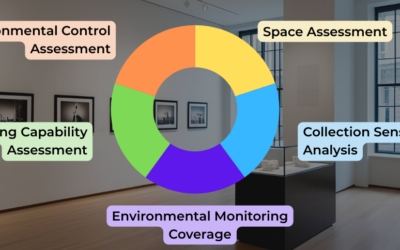If you are a collections care professional who does not work with public-facing tasks but rather with the management and stewardship of the collections, chances are you already have some sort of environmental monitoring setup. Or perhaps you are in an older institution that never got around to implementing that, and it’s time to set you up for the first time. Then again, there’s always the chance that whatever you have has reached the end of its useful life and you are looking for a replacement – hopefully something that will fit your budget and last you for a long time.
If you have decided to move past data loggers that require manual collection of some sort, either USB sticks, cables or Bluetooth downloads, we recommend that you keep doing a bit of research to find your best match. In particular, don’t miss out on the other articles we wrote comparing WiFi, Bluetooth and LoRaWAN and the one we wrote on which type of network might be best depending on your type of institution. If you are more visually inclined, check out the webinar recording of our LoRaWAN event. We talked about the main characteristics of LoRaWAN and its applications to collecions care.
As we continue to write content to help you gauge your options, this particular article will delve into the differences between WiFi data loggers and LoRaWAN data loggers.
What is a WiFi data logger?
This probably doesn’t need a very long explanation, as you are probably well aware of what WiFi data loggers are. You either have one or you wish you did! Still, in case you are still starting out with environmental monitoring, a WiFi data logger is a device that measures one or more environmental parameters, such as temperature, humidity, light, etc., and sends the data to a cloud server via a WiFi network.
You can access the data from any device with an internet connection, such as a computer, tablet, or smartphone. You can also set up alerts and notifications to inform you of any changes or problems in the environment. Your data logger itself will be mostly in charge of measuring and sending data to a cloud server. What you can do with this information will be more dependent on the associated software than the data logger itself, so make sure you do your research on software as well.
Some of the benefits of using a WiFi data logger are:
- Generally easy to install and configure although this will depend on your wireless network and IT security standards.
- Depending on the brand, you may not need a separate gateway as your data logger will connect to your existing network router.
- Real-time data access and analysis.
- Remote control and management.
Some of the drawbacks of using a WiFi data logger are:
- Dependence on WiFi network availability and stability.
- Potential security risks of data transmission and storage. It is possible for a hacker to access your institutional network by breaking into your WiFi data logger first. Make sure you check with your IT administrator before buying a WiFi data logger that may have no encryption or firmware security and which you may not be allowed to set up.
- Higher power consumption and battery replacement. WiFi is capable of sending large packets of information. This means it can go through your batteries much faster than you’d like. Be sure to use good quality batteries as we have heard of many people who have lost signal because their batteries leaked, or they ran really fast. Having to change batteries constantly and trying to find why your sensor does not work when you just changed batteries will just add you another unnecessary headache.
- Limited range and coverage, especially if you have basement collections or many high-density shelving units.
What is a LoRaWAN data logger?
A LoRaWAN data logger is a device that uses a low-power wide-area network (LPWAN) technology called LoRaWAN to transmit the environmental data to a cloud server. LoRaWAN is a wireless communication protocol that allows long-range and low-power data transmission between devices and gateways. Just like with WiFi data loggers, you can access the data from any device with an internet connection, as well as set up alerts and notifications.
Some of the benefits of using a LoRaWAN data logger are:
- Long-range and low-power data transmission.
- High reliability and security of data transmission and storage. The data is encrypted, and since you are not connected to your institutional WiFi, someone hacking into your data logger will not be able to jump into your WiFi network from there.
- Low power consumption and battery replacement. In Conserv’s case, we are talking about a battery that lasts about 3 years so that we will replace your whole sensor before your battery runs out.
- Wide coverage and scalability.
- Plug and play capabilities. It works out of the box, so you don’t need to get IT to help you set it up.
- Remote firmware updates ** This is an upcoming feature with the SCS-3 sensor.
Some of the drawbacks of using a LoRaWAN data logger are:
- Initial price, although this evens out over time.
- Need for additional hardware (gateway).
Which one is better for collections care?
There is no definitive answer to this question as both WiFi data loggers and LoRaWAN data loggers will collect the information you require, and collections care will depend on your proactive decision-making more than on your equipment choice. However, here are some factors to consider when choosing between a WiFi data logger and LoRaWAN data logger for collections care:
- The size and layout of your collection space. Check out this article to help you figure out the particular issues for environmental monitoring based on your institution type.
- The availability and quality of your WiFi network. Stay away from WiFi data loggers if you already regularly have issues with your WiFi. It just won’t work.
- The number and type of environmental parameters you want to measure. Different brands of WiFi data loggers will have different sensors and parameters as well as accuracy and annual drift. Make sure you look into that before you finalize your decision.
- The frequency and granularity of data collection and analysis you need.
- The budget and resources you have for environmental monitoring. Here are five options you can look at in 2023.
To help you make an informed decision, here are some examples of collections that use Conserv LoRaWAN data loggers for their environmental monitoring and short stories of their experiences:
- University of Wyoming Art Museum
- Shelburne Museum
- The OZ Museum
- Utah State University Eastern Prehistoric Museum
Conclusions
WiFi data loggers and LoRaWAN data loggers are both useful tools for collections care professionals who want to monitor the environmental conditions of their collections. They both have their pros and cons that depend on various factors such as your collection space size/layout/network/parameters/frequency/budget/etc. You should weigh these factors carefully before choosing one or the other for your collections care.
We hope this blog post has helped you understand the differences and similarities between a WiFi data logger and a LoRaWAN data logger for collections care. If you have any questions or comments, please feel free to contact us. And don’t forget you can try out the Conserv Cloud platform for free to test it out before you purchase any loggers.
If you have any questions about environmental monitoring, integrated pest management, or just want to talk about preventative conservation, please reach out to us! Don’t forget to check out our blog or join our community of collections care professionals where you can discuss hot topics, connect with your peers or even take a course to get familiar with the Conserv platform.




